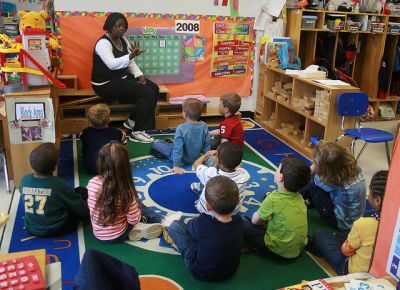Working as a childcare professional can be a challenge especially when dealing with behavioural problems which may arise. The techniques we use when dealing with children's behaviour are obviously going to be different than those used by parents. Our aim is to provide the children with a positive atmosphere and establishing opportunities for recognizing and reinforcing appropriate behaviour.
The strategies listed below will enable you to maintain responsible behaviour and help you to prevent undesirable behaviour, for each child.
Set Limits in a Positive Way, rather than in a Negative Way
Talk to children about limits in a positive way which focuses on what to do, rather than what not to do. This reinforces to the children on what is appropriate and by role modelling the right way to communicate the children will begin to observe and imitate you.
Instead of:
- Don't leave the puzzle on the floor.
Say:
- It's a good idea to put the puzzle away.
Instead of:
- Don't be rough with the keyboard.
Say:
- Tap the keyboard gently.
Provide Simple Explanations for Limits
When children understand the reasons for limits they are more likely to follow them. Teaching children the reasoning for a limit helps them to gain a better understanding of why the limit is put in place.
Example:
- We play with the sand gently, so it doesn't go into our friends eyes.
- When we pack away the toys, we can find them easily again when we want to play with them and they won't go missing.
Set Clear, Consistent and Simple Limits
Limits are statements made either verbally or non – verbally. They are used to ensure children know what is expected of their behaviour. When setting limits it's important to keep them simple and only enforce limits that a necessary. The children are required to learn 20 different limits that you have set.
Example:
- We use our walking feet inside.
- Chairs are for sitting on.
- We use our quiet voices during rest time.
Focus on the Behaviour, not the Child
When you focus on the child's behaviour, rather than on the child, you offer positive guidance for developing positive behaviour. However, when focusing on the child rather than the behaviour, this will generate feelings of guilt, shame and the child will develop low self esteem. After all it's the behaviour that's the problem, not the child.
Instead of:
- You should be ashamed of yourself for grabbing the bike off Joe.
Say:
- When you grabbed the bike off Joe, it really upset him.
Instead of:
- You bad boy, you won't stop until you have hurt yourself.
Say:
- It's not safe to climb up onto the tables.
Provide Choices to the Child
Providing choices to a child will be helpful in avoiding power struggles (especially for young children). When offering real alternatives to a child, you are providing an opportunity to exercise choice and it is likely that the child will co-operate with the task.
Instead of:
- I want you to get dressed now.
Say:
- What would you like to put on first your pants or your shirt?
Instead of:
- I want you to get ready now.
Say:
- What would you like to do first put on your shoes or fix your bed.
Recognize and Reinforce Appropriate Behaviour
When a child is doing well it's so important to acknowledge this through words or gestures. Positive reinforcement helps children build self esteem and encourages them to continue with desired behaviour. It's vital to recognize and reinforce the specific behaviour not the child.
Instead of:
- Good boy Jack.
Say:
- Thank you Jack for taking turns with Tim. That's very kind of you.
Instead of:
- You are my best helper.
Say:
- When you tidy up, it makes our room look very clean.
Instead of:
- I'm so proud of you.
Say:
- You deserve to be proud of your painting. You worked very hard on it.
State Expectations, not ask Questions
When establishing routines, limits and expected behaviours, it's important to state rather than to ask. By asking questions offers a child with a choice. There are many opportunities throughout the day for children to make appropriate choices however when there is no choice (like going to the toilet when a child's need to or packing away for lunch) make a clear statement of what is expected.
Instead of:
- Do you want to pack away?
Say:
- It's time for everyone to pack away now.
Instead of:
- Do you want to go home now?
Say:
- Dad's here. It's time to go home.
Instead of:
- Are you going to listen or not?
Say:
- Sit down on the mat and wait for your name to be called.
Allow time for Child to Respond to Expectations
Children react better when they are offered cues and warnings (not threats). This helps them to prepare for change. Give children time to respond, rather than demanding immediate results.
Instead of:
- I want this packed away now.
Say:
- In five minutes, it will be time to pack away.
Instead of:
- There won't be a story, if you don't sit down now.
Say:
- I'm waiting for everyone to sit down on the mat, before I read this story.
Encourage Child to Seek Help
Children have a greater sense of comfort and trust when they know that you (childcare worker) is there to protect, guide and help them. It's important for you to be willing to listen and respond to each and every child in a fair and supportive manner.
Instead of:
- I'll do it, it looks too hard for you.
Say:
- If you are not sure what to do, ask me and I'll help you.
Instead of:
- Don't be silly, you are a big boy, go and talk to George yourself.
Say:
- I'll stand here beside you, while you ask George if you can join in with his game.
Responding to Minor Issues & Supervise
As a childcare professional you need to develop a tolerance for a certain amount of noise, clutter and attention seeking behaviour. As long as the children's activities are not disturbing others, it's best to count to 10 rather than make a big deal out of a small issue.
When you observe the children at their activities, you are in a better position to deal with potential difficulties and step in to prevent problems as they arise.
It's important to remember that each and every child is different and this is your chance to guide each child's behaviour in an appropriate manner while maintaining each child's self esteem and opportunities to grow and develop.
It's vital that all childcare staff within the centre are all following the same behavioural management strategies and are consistent with the techniques. This is important for building positive relationships between childcare staff and the children.
By establishing clear and simple limits and by continually reinforcing and acknowledging positive behaviour, it will help you to establish positive relationships between you and each individual child as they begin to grow and develop in a safe learning environment.




 As an Educator in Australia, your pay rate falls under the Children’s Services Award 2010. This award states the minimum amount that an employer can
As an Educator in Australia, your pay rate falls under the Children’s Services Award 2010. This award states the minimum amount that an employer can When working as a qualified Early Childhood Teacher (with a university degree) within a service, your rate of pay will come from the Educational Services
When working as a qualified Early Childhood Teacher (with a university degree) within a service, your rate of pay will come from the Educational Services When working as a Diploma Qualified Educator your pay rate is from the Children's Services Award 2010. This Award states your minimum rate of pay
When working as a Diploma Qualified Educator your pay rate is from the Children's Services Award 2010. This Award states your minimum rate of pay When working as a Cert 3 Qualified Educator, your pay rate is from the Children's Services Award 2010. This Award states your minimum rate of
When working as a Cert 3 Qualified Educator, your pay rate is from the Children's Services Award 2010. This Award states your minimum rate of Educational Leaders play a crucial role in their early childhood service by ensuring that the educational program aligns with best practices and supports the holistic
Educational Leaders play a crucial role in their early childhood service by ensuring that the educational program aligns with best practices and supports the holistic In early childhood education and care, ratios are more than a technicality—they are a frontline safeguard. Every child deserves responsive supervision, emotional connection, and developmental
In early childhood education and care, ratios are more than a technicality—they are a frontline safeguard. Every child deserves responsive supervision, emotional connection, and developmental With the new national child safety reforms kicking in on 1 September 2025, early childhood services like yours have a real opportunity to lead the
With the new national child safety reforms kicking in on 1 September 2025, early childhood services like yours have a real opportunity to lead the Here’s a comprehensive Mobile Phone and Smart Watch Policy tailored for early childhood education and care (ECEC) services in Australia, aligned with the latest 2025
Here’s a comprehensive Mobile Phone and Smart Watch Policy tailored for early childhood education and care (ECEC) services in Australia, aligned with the latest 2025 The Sea of Fish Challenge is a national initiative that invites children, educators, families, and communities to create and display fish artworks as a symbol
The Sea of Fish Challenge is a national initiative that invites children, educators, families, and communities to create and display fish artworks as a symbol Across the early childhood education and care sector, educators are sounding the alarm: current staffing ratios are insufficient to deliver safe, meaningful, and developmentally appropriate
Across the early childhood education and care sector, educators are sounding the alarm: current staffing ratios are insufficient to deliver safe, meaningful, and developmentally appropriate


